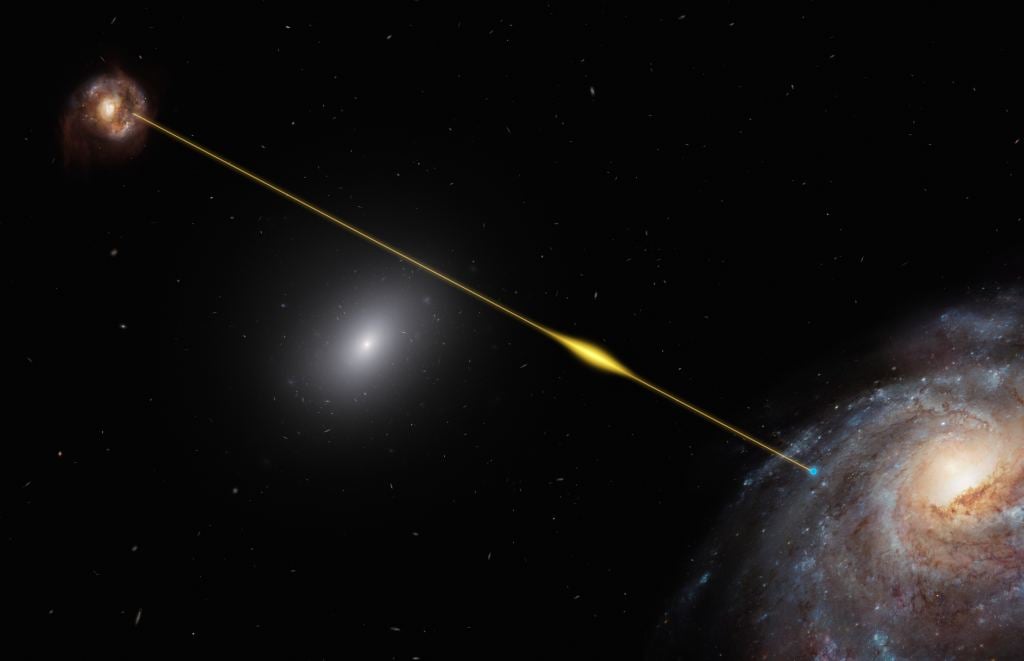Where is all the missing matter? That question has plagued astronomers for decades, because the Universe looks emptier than it should, given current theories about its makeup. Most of the Universe (70%) appears to be composed of Dark Energy, the mysterious force which is causing the Universe's rate of expansion to increase. Another 25% of the Universe is Dark Matter, an unknown substance which cannot be seen, but has been theorized to explain the otherwise inexplicable gravitational forces which govern the formation of galaxies. That leaves Baryonic Matter - all the normal 'stuff' like you, me, the trees, the planets, and the stars - to make up just 5% of the Universe. But when astronomers look out into the sky, there doesn't even seem to be enough normal matter to make up 5%. Some of the normal matter is missing!
Where is it? It's probably out there, but it might just be hard to see, perhaps taking the form of gas clouds that don't produce enough light to be easily visible. So how do you look for nearly invisible matter? The discovery of Fast Radio Bursts (FRB) in 2007 provided an answer. A team of researchers lead by J.-P. Macquart and J.X. Prochaska theorized that if you knew the distance to the origin point of an FRB, you would be able to measure how much matter the radio burst had passed through on the way to Earth. This is because radio waves slow down as they pass through Baryonic Matter, and longer wavelengths slow down more than short ones. So if there was any Baryonic Matter between the source of the FRB and the telescope on Earth, the shorter wavelengths would arrive first, and the longer ones would arrive later.
Testing this theory would have to wait more than a decade, until a telescope capable of determining the origin point of an FRB was developed. This was the Australian Square Kilometre Array Pathfinder (ASKAP), which found its first FRB source in 2017. In 2020, Macquart, Prochaska and their team were able to use ASKAP data to confirm that indeed, the FRBs were passing through some previously unseen normal matter - the missing matter was found!
That's not the end of the story, however. There were lots of questions left: What does this matter consist of? What shape does it take? How does it influence the evolution of galaxies? In early 2021, PhD student Yuanming Wang and a team of researchers including her supervisor, Tara Murphy, published a paper delving into some of these questions. They used a slightly different method to find the missing Baryonic Matter: the team observed the 'twinkle' of galaxies with bright quasars at their centers. Just as stars twinkle because their light is disturbed as it passes through Earth's atmosphere, these galaxies appear to twinkle when their light passes through the gas which makes up the missing Baryonic Matter.
ASKAP is able to observe thousands of galaxies at once, and by observing which galaxies were twinkling and which were not, Wang and the team were able to not only see the missing matter, but get a rough estimate of its shape! It appears to be a gas cloud with a long, thin shape, stretched out in a straight line over vast distances.
Long, narrow gas clouds like this can be formed when a black hole strips gas away from a star that ventures too close. But in the absence of a black hole, Wang suggests that a cold 'snow cloud' made of Hydrogen might have been pulled into this thin, wispy shape by a passing star.
The next step is to broaden the scope of the study, in the hopes of seeing more of these clouds, their shapes, and how they fit into the formation of the Milky Way. It's an exciting time to be made of Baryonic Matter - we're just starting to be able to see the rest of the 'stuff' like us.
References:
- Renyue Cen and Jeremiah P. Ostriker. "Where Are the Baryons?"The Astrophysical Journal* (1999) 514* 1.
- Macquart, JP., Prochaska, J.X., McQuinn, M. et al."A census of baryons in the Universe from localized fast radio bursts."Nature581, 391–395 (2020).
- Yuanming Wang, Artem Tuntsov, Tara Murphy, et al*. "ASKAP observations of multiple rapid scintillators reveal a degrees-long plasma filament."Monthly Notices of the Royal Astronomical Society*, (2021) stab139.
- Yuanming Wang and Tara Murphy, "5 twinkling galaxies help us uncover the mystery of the Milky Way’s missing matter."The Conversation.
- J.-P. Macquart and J.X. Prochaska, "Half the matter in the universe was missing – we found it hiding in the cosmos."The Conversation.
 Universe Today
Universe Today


